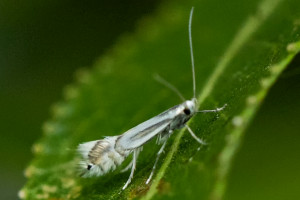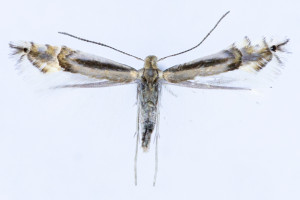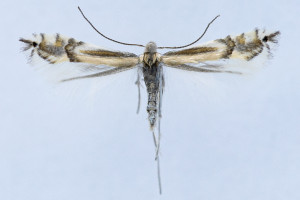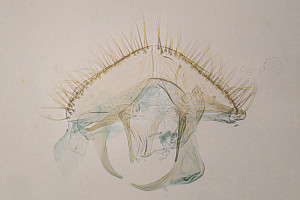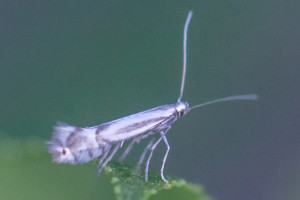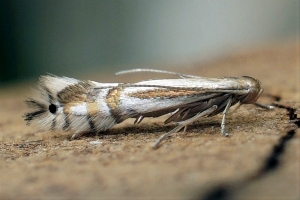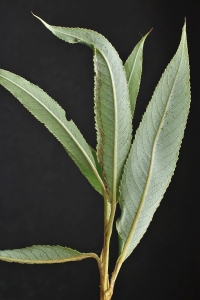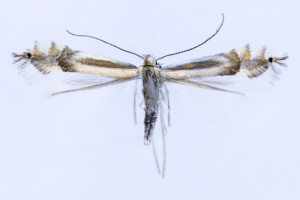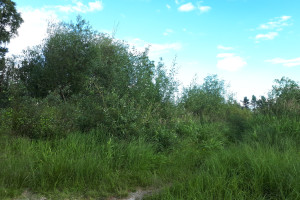1. Lebendfotos
1.1. Falter
1.2. Mine
2. Diagnose
2.1. Männchen
2.2. Weibchen
2.3. Genitalien
2.3.1. Männchen
2.3.2. Weibchen
2.3.3. Differentialdiagnose der Weibchen der saligna-Gruppe
Siehe Phyllocnistis saligna.
3. Biologie
3.1. Nahrung der Raupe
- [Salicaceae:] Salix triandra (Mandel-Weide)
- [Salicaceae:] Salix babylonica (Trauer-Weide)
- [Salicaceae:] Salix euxina
Voith et al. (2023: 19) schildern recht ausführlich: "According to information in the BOLD database (accessed 28.10.2022) bred from Salix babylonica var. matsudana Koidz and S. euxina V.I. Belyaeva in the Czech Republic. In Norway the only observed host-pIant is Salix triandra (Figures 19–21). Oviposition takes place on the underside of the leaf. The newly hatched larva enters the leaf and starts to form a tiny mine, always on the underside. The mine is extended, directly or with some sinuosity, to the main vein of the leaf which it then follows to the petiole and hence into the stem. The mine continues in the stem usually downwards for 5–10 cm, normally either to the first or second petiole before it turns 180 degrees and continues upwards for some 10–20 cm, either to the third or fourth petiole. Then the larva will enter a new leaf via the petiole where it makes a fairly straight mine in the middle up to two thirds or three quarters of the leaf’s length. From there it will either mine straight to the margin to pupate, or cross over to the opposite side of the leaf where it makes a fold at the margin in which it forms a chamber under the epidermis and spins a loose white cocoon where the pupation takes place." Weitere Details sind der dortigen Bebilderung zu entnehmen.
Die Hoffnung, dass die einzelnen Arten der Phyllocnistis saligna-Gruppe sich sicher anhand der Nahrungspflanzen unterscheiden lassen, ist leider zu begraben. Zwar hat P. saligna ihren Schwerpunkt n Salix fragilis, Salix alba und Salix purpurea, doch ist das bei P. asiatica kaum anders, und wenn P. triandricola vielleicht tatsächlich ganz überwiegend an Salix triandra lebt, muss das nicht immer und überall so sein.
(Autor: Erwin Rennwald)
3.2. Habitat
4. Weitere Informationen
4.1. Etymologie (Namenserklärung)
Voith et al. (2023: 22) erläutern ihre Namenswahl: "The species name, triandricola, is from Salix triandra, the scientific name for ‘almond willow’, and the feminine form of incolus, inhabitant. Phyllocnistis triandricola, the Phyllocnistis living on Salix triandra."
4.2. Taxonomie und Faunistik
Die neue Art steht beim Barcoding dem Artenpaar Phyllocnistis saligna / Phyllocnistis asiatica gegenüber. Die morphologischen (einschließlich der genitalmorphologischen) Unterscheidungsmerkmale fallen sehr gering aus und sind nur bei den Weibchen stabil.
Die neue Art wurde aus dem Süden von Norwegen beschrieben, es gibt aber auch passende Barcodes dazu aus Tschechien und aus Kärnten (Österreich).
(Autor: Erwin Rennwald)
4.3. Literatur
- Erstbeschreibung: Voith, R.J.D.I., Aarvik, L., Berggren, K., Bengtsson, B.Å., Hellberg, H., Mutanen, M., Slagsvold, P.K. & C. Wieser (2023): Taxonomy of the complex around Phyllocnistis saligna (Zeller, 1839) (Lepidoptera, Gracillariidae) in North and Central Europe, with the description of a new species. — Norwegian Journal of Entomology, 70, 10–28. [zum PDF-Download auf researchgate.net]

![Vorkommen in Deutschland [Fotos]](/res/img/flag/de.png)

![Vorkommen in Österreich [Voith et al. (2023)]](/res/img/flag/at.png)
![Vorkommen in Norwegen (außer Spitzbergen und Jan Mayen) [locus typicus: Lillehammer: Graverberget]](/res/img/flag/no.gif)
![Vorkommen in Tschechien [Voith et al. (2023)]](/res/img/flag/cz.gif)
![Vorkommen in Belgien [pers. comm. Chris Steeman 30.10.2024]](/res/img/flag/be.gif)
